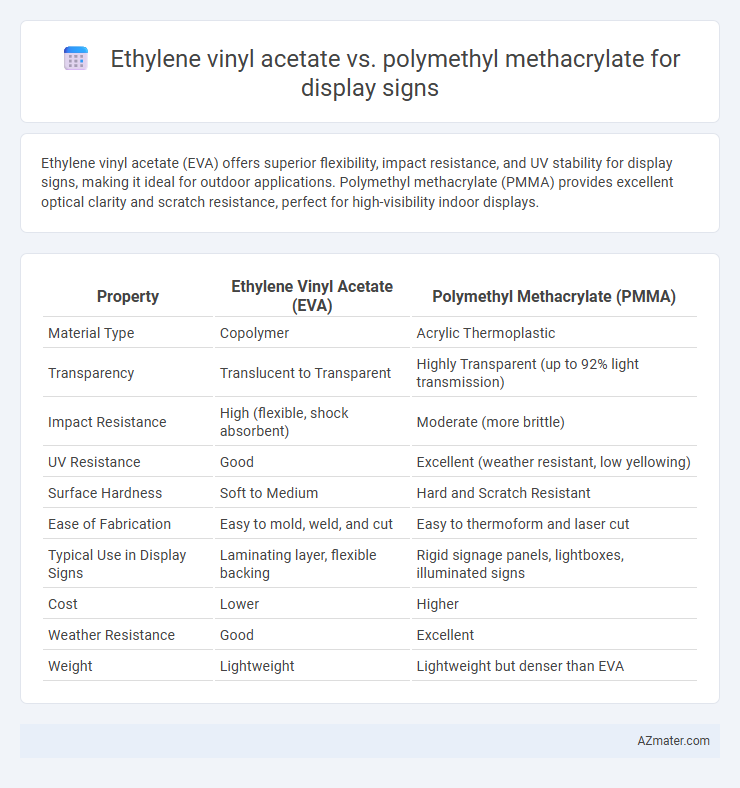Ethylene vinyl acetate (EVA) offers superior flexibility, impact resistance, and UV stability for display signs, making it ideal for outdoor applications. Polymethyl methacrylate (PMMA) provides excellent optical clarity and scratch resistance, perfect for high-visibility indoor displays.
Table of Comparison
| Property | Ethylene Vinyl Acetate (EVA) | Polymethyl Methacrylate (PMMA) |
|---|---|---|
| Material Type | Copolymer | Acrylic Thermoplastic |
| Transparency | Translucent to Transparent | Highly Transparent (up to 92% light transmission) |
| Impact Resistance | High (flexible, shock absorbent) | Moderate (more brittle) |
| UV Resistance | Good | Excellent (weather resistant, low yellowing) |
| Surface Hardness | Soft to Medium | Hard and Scratch Resistant |
| Ease of Fabrication | Easy to mold, weld, and cut | Easy to thermoform and laser cut |
| Typical Use in Display Signs | Laminating layer, flexible backing | Rigid signage panels, lightboxes, illuminated signs |
| Cost | Lower | Higher |
| Weather Resistance | Good | Excellent |
| Weight | Lightweight | Lightweight but denser than EVA |
Introduction to Display Sign Materials
Ethylene vinyl acetate (EVA) offers excellent flexibility and impact resistance, making it suitable for curved or outdoor display signs that require durability and weather resistance. Polymethyl methacrylate (PMMA), commonly known as acrylic, provides superior optical clarity and UV stability, ideal for high-visibility signage with sharp graphics and long-term color retention. Choosing between EVA and PMMA depends on the display sign's environmental conditions, desired visual quality, and structural requirements.
Overview of Ethylene Vinyl Acetate (EVA)
Ethylene Vinyl Acetate (EVA) is a flexible, durable copolymer known for its excellent impact resistance and weatherability, making it ideal for outdoor display signs. EVA offers superior clarity and UV resistance compared to Polymethyl Methacrylate (PMMA), ensuring long-lasting visual appeal. Its adhesive properties and low-temperature toughness provide versatility in various display applications where durability and clarity are essential.
Key Properties of Polymethyl Methacrylate (PMMA)
Polymethyl methacrylate (PMMA) offers superior optical clarity with light transmittance over 90%, making it ideal for high-visibility display signs. Its excellent weather resistance and UV stability ensure long-lasting performance without yellowing or brittleness in outdoor conditions. Compared to Ethylene vinyl acetate (EVA), PMMA provides a harder surface and better scratch resistance, enhancing durability and maintaining a pristine appearance over time.
Visual Appearance: EVA vs PMMA
Ethylene vinyl acetate (EVA) offers a softer, matte finish with excellent flexibility, making it ideal for impact-resistant and lightweight display signs but may exhibit slight yellowing over time. Polymethyl methacrylate (PMMA) provides superior clarity, high gloss, and exceptional UV resistance, ensuring vibrant, transparent signage with long-lasting visual appeal. PMMA's rigidity and scratch resistance make it preferable for premium display signs requiring sharp, crisp imagery compared to the more elastic and less rigid EVA.
Durability and Weather Resistance Comparison
Ethylene vinyl acetate (EVA) offers superior flexibility and impact resistance compared to polymethyl methacrylate (PMMA), enhancing its durability in dynamic environments. PMMA excels in weather resistance due to its excellent UV stability and resistance to yellowing, making it ideal for long-term outdoor display signs. While EVA provides better shock absorption, PMMA ensures clearer visibility and maintains structural integrity under prolonged exposure to sun, rain, and fluctuating temperatures.
Flexibility and Workability in Signage Applications
Ethylene vinyl acetate (EVA) offers superior flexibility and impact resistance compared to polymethyl methacrylate (PMMA), making it ideal for curved or irregular signage applications where bending without cracking is essential. PMMA, known for its rigidity and excellent optical clarity, provides high workability in precision cutting and engraving but lacks the pliability required for flexible displays. Choosing EVA enhances durability and ease of installation in dynamic environments, whereas PMMA excels in static signage demanding sharp visual aesthetics.
Cost-Effectiveness and Availability
Ethylene vinyl acetate (EVA) is significantly more cost-effective than polymethyl methacrylate (PMMA) for display signs due to its lower production and material costs. EVA offers greater availability in bulk quantities, making it ideal for large-scale signage projects where budget constraints are critical. PMMA, while offering superior clarity and durability, typically incurs higher costs and limited supply compared to EVA in standard commercial markets.
Environmental Impact and Sustainability
Ethylene vinyl acetate (EVA) is more environmentally friendly than polymethyl methacrylate (PMMA) due to its improved recyclability and lower production emissions. EVA's biodegradable properties and reduced reliance on fossil fuels contribute to sustainability efforts in display signage applications. Conversely, PMMA, while offering excellent clarity and durability, involves energy-intensive manufacturing and generates non-biodegradable waste, posing greater environmental challenges.
Case Studies and Real-World Applications
Ethylene vinyl acetate (EVA) excels in display sign applications due to its superior flexibility, impact resistance, and UV stability, as demonstrated in outdoor signage case studies where durability under harsh weather conditions is critical. Polymethyl methacrylate (PMMA), known for its excellent optical clarity and scratch resistance, is favored in retail and exhibition displays that require high transparency and aesthetic appeal, supported by real-world applications in storefront and museum signage. Comparative studies highlight EVA's resilience and cost-effectiveness for long-term outdoor use, while PMMA is preferred for high-end indoor displays requiring sharp visibility and minimal degradation.
Choosing the Right Material for Display Signs
Ethylene vinyl acetate (EVA) offers excellent flexibility, impact resistance, and UV stability, making it ideal for outdoor display signs requiring durability and weather resistance. Polymethyl methacrylate (PMMA), known as acrylic, provides superior optical clarity, rigidity, and scratch resistance, making it optimal for indoor signs where visual sharpness and aesthetic appeal are paramount. Choosing the right material depends on factors like environmental exposure, desired visual quality, and mechanical strength specific to the display sign's application.

Infographic: Ethylene vinyl acetate vs Polymethyl methacrylate for Display sign
 azmater.com
azmater.com